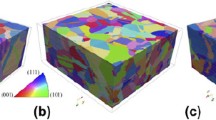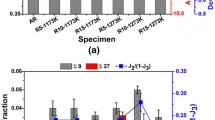Abstract
Characterization of microstructure and grain boundary character distribution (GBCD) during iterative thermo-mechanical processing (TMP) of 316L stainless steel were done using electron backscatter diffraction (EBSD). Results from EBSD scans were analyzed in terms of the fraction of special boundaries, their deviation from ideal misorientation, connectivity of random high-angle grain boundaries, and grain size. In order to understand the efficacy of the iterative processing route leading to a well-connected twin boundary network, additional analysis was done in terms of twin-related domain statistics and triple junction distribution. Results from these analyses show that initial iteration results in a microstructure with insufficient twin boundary density, and a poor twin boundary network. Although the next iteration leads to a small increase in twin statistics, it also does not significantly improve the statistics of favorable grain boundaries and their network. However, the fourth iteration of the processing results in a large improvement in both the population and distribution of favorable grain boundaries. All the subsequent iterations were found to result in microstructural deterioration in terms of both population and network of these grain boundaries. Based on the analysis, role of underlying mechanisms such as strain-induced grain boundary migration and static recrystallization in the effective optimization of GBCD was analyzed. The present research gives important insights into these mechanisms and their control during TMP in order to achieve an engineered microstructure.
Graphic abstract

















Similar content being viewed by others
References
Watanabe T (1984) An approach to grain boundary design for strong and ductile polycrystals. Res Mechanica 11(1):47–84
Watanabe T (1993) Grain boundary design and control for high temperature materials. Mater Sci Eng, A 166(1–2):11–28
Lin P, Aust K, Palumbo G, Erb U (1995) Influence of grain boundary character distribution on sensitization and intergranular corrosion of alloy 600. Scripta Metallurgica et materialia 33(9):1387–1392
Randle V (2010) Grain boundary engineering: an overview after 25 years. Mater Sci Technol 26(3):253–261
Watanabe T (2011) Grain boundary engineering: historical perspective and future prospects. J Mater Sci 46(12):4095–4115. https://doi.org/10.1007/s10853-011-5393-z
Bi HY, Kokawa H, Wang ZJ, Shimada M, Sato YS (2003) Suppression of chromium depletion by grain boundary structural change during twin-induced grain boundary engineering of 304 stainless steel. Scripta Mater 49(3):219–223
Hong H, Rho B, Nam SW (2001) Correlation of the M23C6 precipitation morphology with grain boundary characteristics in austenitic stainless steel. Mater Sci Eng A 318(1–2):285–292
Erb U, Gleiter H, Schwitzgebel G (1982) The effect of boundary structure (energy) on interfacial corrosion. Acta Metall 30(7):1377–1380
Shimada M, Kokawa H, Wang Z, Sato Y, Karibe I (2002) Optimization of grain boundary character distribution for intergranular corrosion resistant 304 stainless steel by twin-induced grain boundary engineering. Acta Mater 50(9):2331–2341
Parvathavarthini N, Mulki S, Dayal R, Samajdar I, Mani K, Raj B (2009) Sensitization control in AISI 316L (N) austenitic stainless steel: defining the role of the nature of grain boundary. Corros Sci 51(9):2144–2150
Adams BL, Olsen T, Panayotou N, Pan Y (1996) Grain-boundary structure effects on intergranular stress corrosion cracking of alloy X-750.
Rahimi S, Marrow T (2020) A new method for predicting susceptibility of austenitic stainless steels to intergranular stress corrosion cracking. Mater Des 187:108368
Watanabe T, Kimura S-I, Karashima S (1984) The effect of a grain boundary structural transformation on sliding in< 1010>-tilt zinc bicrystals. Philos Mag A 49(6):845–864
Mahajan S, Pande C, Imam M, Rath B (1997) Formation of annealing twins in fcc crystals. Acta Mater 45(6):2633–2638
Kumar M, Schwartz AJ, King WE (2002) Microstructural evolution during grain boundary engineering of low to medium stacking fault energy fcc materials. Acta Mater 50(10):2599–2612
Schuh CA, Kumar M, King WE (2003) Analysis of grain boundary networks and their evolution during grain boundary engineering. Acta Mater 51(3):687–700
Kumar M, King WE, Schwartz AJ (2000) Modifications to the microstructural topology in fcc materials through thermomechanical processing. Acta Mater 48(9):2081–2091
Engelberg D, Humphreys F, Marrow T (2008) The influence of low-strain thermo-mechanical processing on grain boundary network characteristics in type 304 austenitic stainless steel. J Microsc 230(3):435–444
McCarley J, Tin S (2018) Utilization of hot deformation to trigger strain induced boundary migration (SIBM) in Ni-base superalloys. Mater Sci Eng A 720:189–202
Randle V (1999) Mechanism of twinning-induced grain boundary engineering in low stacking-fault energy materials. Acta Mater 47(15–16):4187–4196
Randle V (2004) Twinning-related grain boundary engineering. Acta Mater 52(14):4067–4081
Gertsman VY, Henager CH (2003) Grain boundary junctions in microstructure generated by multiple twinning. Interface Sci 11(4):403–415
Gertsman V, Tangri K (1995) Computer simulation study of grain boundary and triple junction distributions in microstructures formed by multiple twinning. Acta Metall Mater 43(6):2317–2324
Barr CM, Leff AC, Demott RW, Doherty RD, Taheri ML (2018) Unraveling the origin of twin related domains and grain boundary evolution during grain boundary engineering. Acta Mater 144:281–291
Cayron C (2007) ARPGE: a computer program to automatically reconstruct the parent grains from electron backscatter diffraction data. J Appl Crystallogr 40(6):1183–1188
Cayron C (2011) Quantification of multiple twinning in face centred cubic materials. Acta Mater 59(1):252–262
Lind J, Li SF, Kumar M (2016) Twin related domains in 3D microstructures of conventionally processed and grain boundary engineered materials. Acta Mater 114:43–53
Joham R, Sharma NK, Mondal K, Shekhar S (2017) Low temperature cross-rolling to modify grain boundary character distribution and its effect on sensitization of SS304. J Mater Process Technol 240:324–331
Sahu S, Sharma NK, Patel SK, Mondal K, Shekhar S (2019) The effect of grain boundary structure on sensitization behavior in a nickel-based superalloy. J Mater Sci 54(2):1797–1818. https://doi.org/10.1007/s10853-018-2919-7
Sharma NK, Shekhar S (2020) New insights into the evolution of twin boundaries during recrystallization and grain growth of low-SFE FCC alloys. Mater Charact 159:110015
Randle V, Jones R (2009) Grain boundary plane distributions and single-step versus multiple-step grain boundary engineering. Mater Sci Eng A 524(1–2):134–142
Randle V (2006) ‘Special’boundaries and grain boundary plane engineering. Scripta Mater 54(6):1011–1015
Engelberg D, Newman R, Marrow T (2008) Effect of thermomechanical process history on grain boundary control in an austenitic stainless steel. Scripta Mater 59(5):554–557
Lim L, Raj R (1984) On the distribution of Σ for grain boundaries in polycrystalline nickel prepared by strain annealing technique. Acta Metall 32(8):1177–1181
Prithiv T, Bhuyan P, Pradhan S, Sarma VS, Mandal S (2018) A critical evaluation on efficacy of recrystallization vs. strain induced boundary migration in achieving grain boundary engineered microstructure in a Ni-base superalloy. Acta Mater 146:187–201
Humphreys FJ, Hatherly M (2012) Recrystallization and related annealing phenomena. Elsevier, Netherlands, pp 251–257
Beck P, Hu H (1950) I. Met. 1 (1949) 627. PA Beck and PR Sperry: 1. App Phys 21:150
Abbaschian R, Reed-Hill RE (2008) Physical metallurgy principles. Cengage Learning,
Owen G, Randle V (2006) On the role of iterative processing in grain boundary engineering. Scripta Mater 55(10):959–962
Fullman R, Fisher J (1951) Formation of annealing twins during grain growth. J Appl Phys 22(11):1350–1355
Gleiter H (1969) The formation of annealing twins. Acta Metall 17(12):1421–1428
Meyers MA, Murr LE (1978) A model for the formation of annealing twins in FCC metals and alloys. Acta Metall 26(6):951–962
Field D, Bradford L, Nowell M, Lillo T (2007) The role of annealing twins during recrystallization of Cu. Acta Mater 55(12):4233–4241
Detrois M, Goetz RL, Helmink RC, Tin S (2016) The role of texturing and recrystallization during grain boundary engineering of Ni-based superalloy RR1000. J Mater Sci 51(11):5122–5138. https://doi.org/10.1007/s10853-016-9815-9
Bai Q, Zhao Q, Xia S, Wang B, Zhou B, Su C (2017) Evolution of grain boundary character distributions in alloy 825 tubes during high temperature annealing: is grain boundary engineering achieved through recrystallization or grain growth? Mater Charact 123:178–188
Bober DB, Lind J, Mulay RP, Rupert TJ, Kumar M (2017) The formation and characterization of large twin related domains. Acta Mater 129:500–509
Brandon D (1966) On a more restrictive geometric criterion for “special” CSL grain boundaries. Acta Metall 14:1479–1484
Lin H, Pope D (1993) The influence of grain boundary geometry on intergranular crack propagation in Ni3Al. Acta Metall Mater 41(2):553–562
King AH, Shekhar S (2006) What does it mean to be special? The significance and application of the Brandon criterion. J Mater Sci 41(23):7675–7682. https://doi.org/10.1007/s10853-006-0665-8
Takehara Y, Fujiwara H, Miyamoto H (2013) “Special” to “general” transition of intergranular corrosion in Σ3 1 1 1 grain boundary with gradually changed misorientation. Corros Sci 77:171–175
Sharma NK, Shekhar S (2017) Cut-off deviation for CSL boundaries in recrystallized face-centered cubic materials. Phil Mag 97(23):2004–2017
Vaid A, Mittal K, Sahu S, Shekhar S (2016) Controlled evolution of coincidence site lattice related grain boundaries. Trans Indian Inst Met 69(9):1745–1753
Li B, Tin S (2014) The role of deformation temperature and strain on grain boundary engineering of Inconel 600. Mater Sci Eng, A 603:104–113
Jin Y, Lin B, Bernacki M, Rohrer GS, Rollett A, Bozzolo N (2014) Annealing twin development during recrystallization and grain growth in pure nickel. Mater Sci Eng A 597:295–303
Sahu S, Yadav PC, Shekhar S (2018) Use of hot rolling for generating low deviation twins and a disconnected random boundary network in inconel 600 alloy. Metall Mater Trans A 49(2):628–643
Kokawa H, Shimada M, Michiuchi M, Wang Z, Sato Y (2007) Arrest of weld-decay in 304 austenitic stainless steel by twin-induced grain boundary engineering. Acta Mater 55(16):5401–5407
Acknowledgement
The authors would like to acknowledge Indian Institute of Technology (IIT) Kanpur for providing requisite fund and support to carry out this research. The authors also acknowledge the help provided by Electron Microscopy Lab at Advanced Centre for Materials Science (ACMS) in conducting EBSD scans.
Author information
Authors and Affiliations
Corresponding author
Additional information
Handling Editor: N. Ravishankar.
Publisher's Note
Springer Nature remains neutral with regard to jurisdictional claims in published maps and institutional affiliations.
Rights and permissions
About this article
Cite this article
Sharma, N., Shekhar, S. New perspectives on twinning events during strain-induced grain boundary migration (SIBM) in iteratively processed 316L stainless steel. J Mater Sci 56, 792–814 (2021). https://doi.org/10.1007/s10853-020-05240-y
Received:
Accepted:
Published:
Issue Date:
DOI: https://doi.org/10.1007/s10853-020-05240-y




